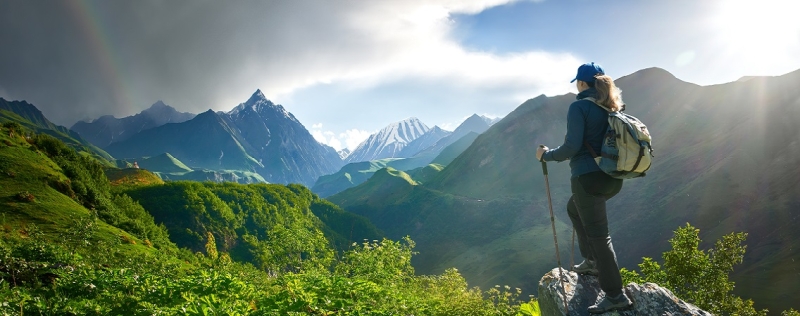
In the summer, it’s worth going to Georgia not only for tasting khinkali, beach holidays and visiting Tbilisi. While the cities are melting from the heat, it’s time to go for a walk among the icy lakes and mountain peaks. We have compiled a selection of popular easy routes in different parts of the country. You can go on easy trekking on your own, but for moderately difficult routes you will need a guide.
To enter, Russians will only need a foreign passport; without a visa, you can stay in the country for 365 days. PCR tests and vaccination certificates will also not be needed – on June 15, the country lifted all restrictions. You can get from Russia to Georgia through the Verkhniy Lars checkpoint if you are prepared for a rather tiring long road. It is more convenient to fly by plane to Tbilisi or Kutaisi, but you will have to make a transfer, for example, in Minsk.
Church of the Holy Trinity
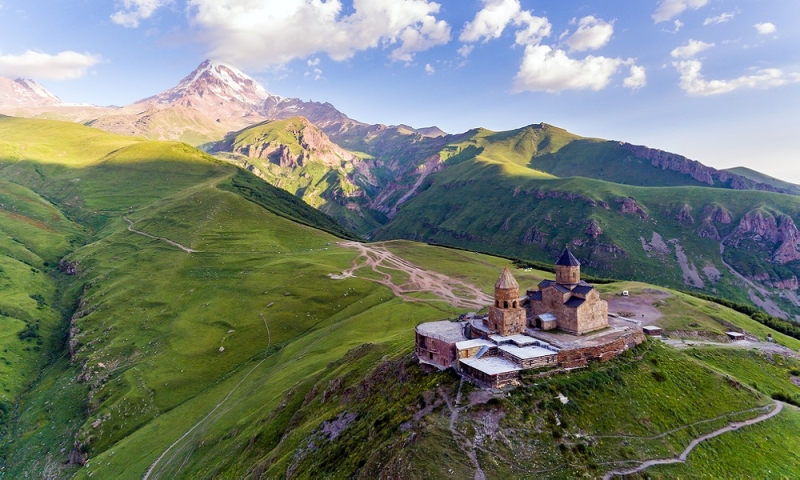
Difficulty: easy
You’ve probably seen this “postcard” location in photographs: a small church huddles high in the mountains, and behind it, among the stew of clouds, the majestic Kazbek appears and disappears. Perhaps this is one of the most striking Georgian attractions, for which you can travel a rather long distance of 160 km from Tbilisi along the old road. The nearest settlement, the village of Kazbegi, can be reached by minibus; it departs from the Tbilisi bus station, located near the Didube metro station. To make your trip more comfortable and faster, we recommend renting a car.
The Church of the Holy Trinity in Gergeti is a place where the culture of the country and its natural beauty come together. It is located at the foot of Mount Kazbek, in the Khevi gorge, at an altitude of 2,170 meters above the village of Kazbegi. Don’t let these numbers scare you, because the city itself is located at 1,744 meters. The path to the goal runs through the village of Gergeti, the ascent takes about two hours. We recommend admiring the modest decoration of the temple and, if you’re lucky, listening to the singing and prayers of the ministers.
At the temple you can replenish your supply of drinking water and take a walk in the surrounding area – here it seems that Kazbek is very close, so you can arrange a spectacular photo session against the backdrop of mountains and alpine meadows. After the walk, it will be especially pleasant to refresh yourself with dishes of Georgian cuisine in one of the Kazbegi cafes.
Where to stay
The church looks absolutely special at night, when the moon rises and floods the valley with light. The domed temple “nests” high on the peak and blinks with a bright light against the backdrop of the snow-white cap of Kazbek. Therefore, we recommend staying in Kazbegi to enjoy the views at different times of the day. We selected hotels with good guest ratings:
Cliff House (rating 10 out of 10) – from 3,750 rubles* per night in a double room;
Discover Kazbegi Hotel (rating 10 out of 10) – from 3,100 rubles* per night in a double room;
Sunny Mountain House (rating 9.7 out of 10) – from 2,000 rubles* per night in a double room.
Birtvisi Canyons
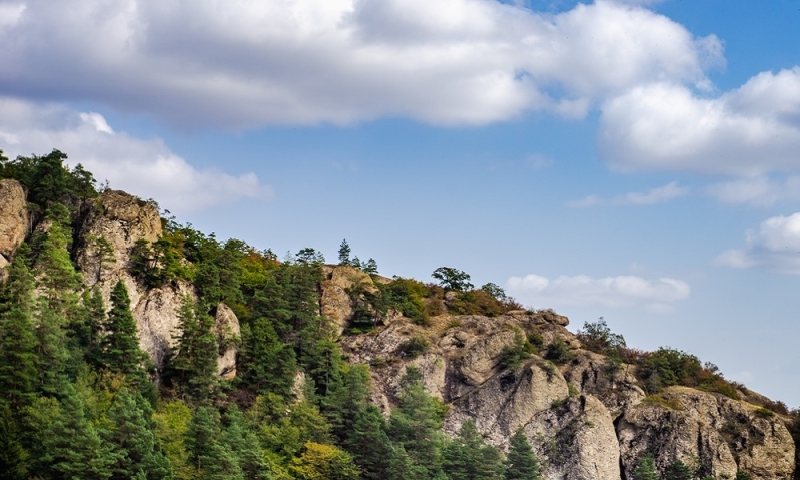
Difficulty: easy
The route is suitable for those who do not want to travel far from Tbilisi or do not have much time left. The canyons are located 80 km from the city, in the Kvemo Kartli region. The first thing you need to do is get by car to the village of Partskhisi and from there walk 2 km to the village of Tbisi. The village itself is located on the left side of the road, and a couple of buildings and a trail with a sign are on the right. The hiking path to the canyons is 3.5 km; the hike takes 3-4 hours.
Interestingly, canyons are divided into “dry” and “wet”. “Dry” is a forested area with huge boulders of stone rising throughout its entire territory. “Wet” are waterfalls and natural baths that stretch for a distance of about 7 km. It is impossible to walk the entire “wet” canyon without special equipment and the help of instructors, so first we recommend visiting the more familiar “dry route”. You will find a mysterious atmosphere inherent in the forest paths, the remains of the ancient defensive fortress of Birtvisi and views of the bizarre mountain ranges opening from the plateau. The highest point of the canyons is located at an altitude of 1,200 meters above sea level, so stock up on nuts and snacks to ensure you have the strength to climb higher.
Not far from the location there is the Algeti Reservoir. You can go down there after active trekking and have a picnic by the cool water.
Where to stay
If you want to wander longer among the labyrinths of canyons, you can spend the night in a tent on one of the picturesque hills. Or return to Tbilisi for a walk around the evening city, drink a glass of Kindzmarauli and taste khinkali. Here are some hotel options:
Kisi by Tbilisi Luxury Boutique Hotels (rating 9.5 out of 10) – from 6,859 rubles* per night in a double room;
Stamba Hotel (rating 9.4 out of 10) – from 23,400 rubles* per night in a double room;
Holiday Inn Tbilisi (rating 9.1 out of 10) – from 8,850 rubles* per night in a double room.
Abudelaur lakes
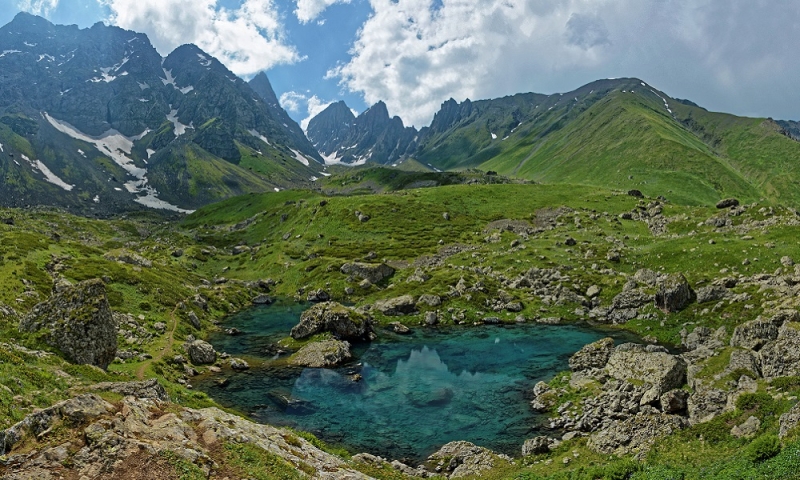
Difficulty: easy
The location is located at the foot of the Chaukhi pass, on the southern slopes of the Tusheti-Khevsuret part of the Eastern Caucasus Range at an altitude of 2,600 – 2,800 meters. The nearest settlement is the village of Roshka (Khevsureti), from it to Abudelauri about 7 km.
The most convenient way to get to Roshka is by car; the journey will take about two hours. There is a parking lot near the village where you can leave your car. From here begins the trail marked in white and blue towards the lakes. This is a fairly easy route: the path seems to be framed by steep slopes on all sides, so it is very difficult to take a wrong turn. A green valley with colorful lanterns of alpine colors can be seen far ahead. But the weather in the mountains is changeable, so you always need to be prepared for sudden fog or rain. Be sure to bring a fleece jacket, windbreaker, and raincoat. Trekking shoes should be worn in, with a tight toe to protect your feet from sharp stones. On the road to the lakes you will be accompanied by the Abudelauri River; in some places you will have to jump over it, in others you will have to ford it. At the end of summer and beginning of autumn, the rivers become shallow, so this will be a fun attraction that you will remember with a smile for a long time.
The Abudelauri lakes are interesting because they are located 1.5 km from each other and at the same time have completely different shades of water. Therefore, they are also traditionally called “colored” lakes. Green (due to shallow water) most reflects the riot of lush greenery around. White Lake is the highest mountain lake, its water has a milky hue, because its bottom is covered with glacial deposits. Blue has a noble dark blue hue and is rightfully considered the most beautiful. It is framed by rhododendron bushes, so local trekkers often go to the lakes especially during the flowering period of this plant. And they can be understood: white flower buds harmoniously dilute the blue water surface.
You can set up a camp near the lakes with a view of the jagged mountain peaks, which are intricately reflected in the glacial waters, or return to Roshka.
Where to stay
To extend the adventure, you can stay in a guesthouse in Roshka and live a little more among nature in a small village. Or grab some food at a local cafe and hit the road. The closest suitable option for a comfortable stop will be Dusheti. The journey will take about two hours. Several hotels where you can comfortably stay:
Verona Apartment (rating 10 out of 10) – from 1,770 rubles* per night in a double room;
Laguna Beach Club (rating 9 out of 10) – from 3,970 rubles* per night in a double room.
Cozy cottage in countryside close to Tbilisi (rating 8 out of 10) – from 7,280 rubles* per night in a house.
Juta – Roshka
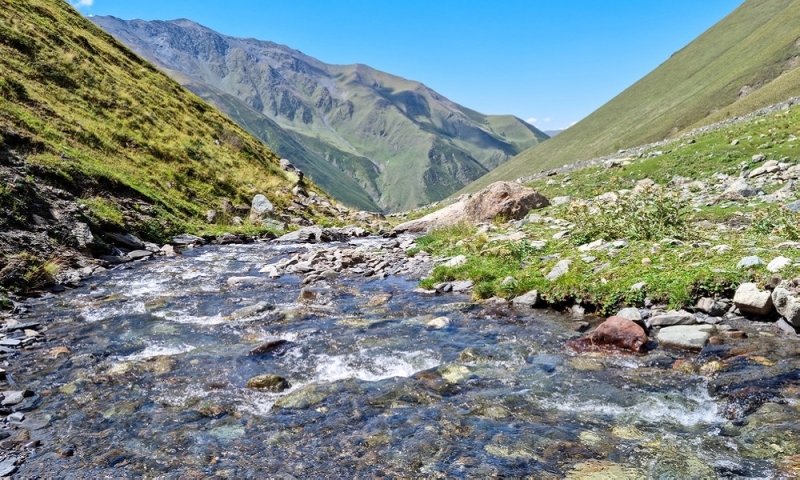
Difficulty: medium
The path from Juta to Roshka is suitable for those who are not going on hikes for the first time. In essence, this is an improved trekking to the Abudelaur lakes, only now you have to climb the Chaukhi pass to 3,300 meters and only then descend to your destination. The route requires an overnight stay, so you will need good preparation and a guide. The mountain slopes in many parts of the trail consist of sharp shale, so having strong and comfortable boots is a must for this trip.
The start begins in the village of Juta, which can only be reached on foot or by a four-wheel drive vehicle from the village of Sno. Where, in turn, do minibuses go from Tbilisi or Kazbegi. The valley through which the path will run is truly fabulous: horses peacefully nibble grass in the surrounding area, mountain streams run down the terry hills, and sharp jagged rocks dig into the sky. The pass offers views of endless ridges of peaks, which in good weather seem to be shrouded in a bluish haze and resemble watercolors. The descent is quite steep, so be patient. As a reward, below you will find landscapes of the Abudelaur lakes, which are somewhat reminiscent of footage from the film “The Lord of the Rings”. Don’t forget to charge your smartphones and take a power bank with you—you’ll want to take a lot of photos! After a leisurely breakfast, you can hit the road – by lunchtime you will be in Roshka, from where you can drive to Tbilisi.
Where to stay
In Juta, you can stay longer and be surrounded by mountain serenity. Here are some good places:
Hotel SHIBI (rating 9.1 out of 10) – from 2,650 rubles* per night in a double room;
Fifth Season (rating 8.9 out of 10) – from 6,100 rubles* per night in a double room;
Juta Guest House (rating 7.7 out of 10) – from 4,850 rubles* per night in a double room.
Mestia – Ushguli

Difficulty: easy/medium
A completely outlandish “other” Georgia is located in the Svaneti region, which is located in the north-west of the country. You should allow 7–10 days for the trip. On a multi-day hike, you will be able to get acquainted with the life of the Svans, visit the highest mountain settlement in Europe – Ushguli, and enjoy views of rivers, glaciers and mountain meadows. The track is well marked on the ground, so if you are confident in your abilities and have extensive experience in mountain hiking, you can correctly calculate how much provisions you need to take with you on the road, and are ready to plan the route – you can go through it yourself (by installing maps.me first) . Or still use the services of guides.
To get to Mestia from Tbilisi, you will have to travel almost the entire country – the road will take about 470 km. Therefore, as an option, you can fly directly to Kutaisi, which is twice as close to the starting point. The road from the airport to Mestia will take 4-5 hours by car. The route itself starts from the Mestia Ethnographic Museum on the right bank of the Tsaneri River and goes east to the Mulakhi community. Further, the trail passes through the Tsaneri gorge, the village of Adishi, the Adishi and Khaldechala gorges, the Khalde glacier, the Chkhunder pass and descends to the high-mountainous settlement of Ushguli along the Inguri River. Perhaps one of the most vivid impressions that awaits you is the panorama of the huge tongue of the glacier, which slides into the valley like moraines, unusual Svan towers included in the list of UNESCO World Heritage Sites, pink lanterns of wildflowers waving in the wind among a huge wall of ice and Shkhara mountains.
Where to stay
After a multi-day route, the most desirable things are usually: a hot shower, white starched sheets, a bottle of cold lemonade and a leisurely dinner on a cozy terrace. All this can be found in the small town of Mestia, where we recommend returning to gain strength and relax. You can stay in one of the hotels:
Guesthouse Data (rating 9.7 out of 10) – from 1,550 rubles* per night in a double room;
Hotel Posta (rating 8.4 out of 10) – from 2,200 rubles* per night in a double room;
Hotel Svaneti (rating 7.6 out of 10) – from 10,140 rubles* per night in a double room.
*Prices are provided as of mid-September and are valid at the time of publication.

